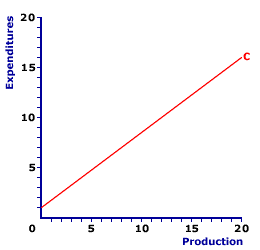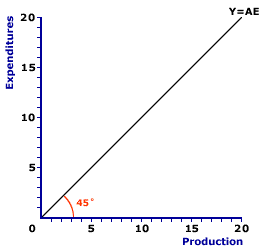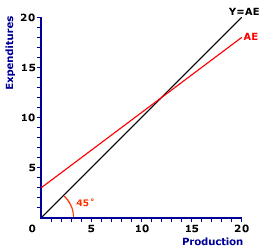
|
|
M: The standard abbreviation for imports produced by the domestic economy and purchased by the foreign sector, especially when used in the study of macroeconomics. This abbreviation is most often seen in the aggregate expenditure equation, AE = C + I + G + (X - M), where C, I, G, and (X - M) represent expenditures by the four macroeconomic sectors, household, business, government, and foreign. The United States, for example, buys a lot of the stuff produced within the boundaries of other countries, including bananas, coffee, cars, chocolate, computers, and, well, a lot of other products. Imports, together with exports, are the essence of foreign trade--goods and services that are traded among the citizens of different nations. Imports and exports are frequently combined into a single term, net exports (exports minus imports).
Visit the GLOSS*arama
|
|


|

|
                           TWO-SECTOR KEYNESIAN MODEL: A Keynesian model of the macroeconomy that includes the two private sectors, the household sector and the business sector. This Keynesian model variation, often termed the basic Keynesian model or the private sector Keynesian model, captures the interaction between induced consumption expenditures and autonomous investment expenditures. This model is commonly used to illustrate the basic workings of Keynesian economics, including equilibrium, disequilibrium, and the multiplier. Equilibrium is identified as the intersection between the C + I line and the 45-degree line. Two related variations are the three-sector Keynesian model and the four-sector Keynesian model. The two-sector Keynesian model is the simplest representation of the key principles of Keynesian economics. It is commonly termed the basic or private sector Keynesian model because it (1) captures the basic essence of Keynesian economics and (2) includes only the two private sectors--household and business. This variation is typically used in introductory economics courses to introduce Keynesian economic theory.The Private SectorTo get the ball rolling consider the private sector, which is the combination of the household sector and the business sector, the two domestic sectors that engage in voluntary market exchanges and allocate resources through individual decisions.The private sector should be contrasted with the public sector, or government sector, which is the sector that forces involuntary resource allocation decisions on the rest of the economy through laws, rules, and regulations. The distinction between the private and public sectors is critical in Keynesian economics. This is largely due to the Keynesian view that the private sector (especially the business sector) is the source of business-cycle instability, and that stabilization policies by the public sector are the recommended way of stabilizing the economy. The private sector, as noted above, contains the household and business sectors. - Household Sector: The household sector includes everyone in an economy who consumes goods and services. It is the entire population of an economy. The household sector is responsible for consumption expenditures on gross domestic product.
- Business Sector: The business sector contains the private, profit-seeking firms in the economy that combine scarce resources into the production of wants-and-needs satisfying goods and services. The business sector is responsible for investment expenditures on gross domestic product.
Autonomous and InducedThe inclusion of the household and business sectors highlights a critical distinction between two types of expenditures--autonomous and induced.- Autonomous Expenditure: An autonomous expenditure is an aggregate expenditure (consumption, investment, government purchases, and net exports) that does not depend on national income or gross domestic product.
- Induced Expenditure: An induced expenditure is an aggregate expenditure (consumption, investment, government purchases, and net exports) that depends on national income or gross domestic product.
Even though consumption and investment actually have both autonomous and induced components, the two-sector Keynesian model is generally constructed based on the working assumption that consumption expenditures are induced by income and that investment expenditures are autonomous.This simplification makes it possible to identify two key aspects of Keynesian equilibrium. - First, how equilibrium is disrupted by changes in autonomous expenditures.
- Second, how equilibrium is restored by changes in induced expenditures.
Aggregate Expenditures: The C + I Line| C + I Line | 
|
The place to begin with the two-sector Keynesian model is the aggregate expenditures line. In this particular model, the aggregate expenditures line is comprised of expenditures from the two private sectors--induced consumption expenditures by the household sector and autonomous investment expenditures by the business sector (hence the name "two-sector" Keynesian model).The exhibit to the right can be used to illustrated the two-sector (C + I) aggregate expenditures line. - We begin with the consumption line. This graph measures expenditures on the vertical axis and aggregate production on the horizontal axis. The consumption line (C) presented here is positively sloped. The intercept is autonomous consumption and the slope of the line is induced consumption, measured by the marginal propensity to consume.
- The aggregate expenditures line is derived by adding investment to the consumption line. Investment is assumed to be totally autonomous. As such, the aggregate expenditures line is obtained by adding a constant amount of investment to the consumption line. The resulting aggregate expenditures line can be displayed by clicking the [AE] button.
Equilibrium in the two-sector Keynesian model requires a balance between aggregate expenditures and aggregate production. The aggregate expenditures line is a critical part of this equilibrium, but ONLY part. The other part is an equilibrium guide line.An Equilibrium Guide: The 45-Degree Line| 45-Degree Line |  |
The equilibrium guide line is a 45-degree line that bisects the 90-degree angle formed by the horizontal and vertical axes. The exhibit to the right presents a 45-degree line. Careful measurement of the angle between this line and either the vertical axis or the horizontal axis should confirm a value of 45 degrees. The most important feature of the 45-degree line is that it contains every point in the diagram in which aggregate production is equal to aggregate expenditures. In other words, if you pick an aggregate production value, such as $5 trillion, move vertically to the 45-degree line, then take a right turn to the vertical axis, you reach an equal $5 trillion value for aggregate expenditures. Because this 45-degree line contains EVERY potential equilibrium value for the two-sector Keynesian model, equilibrium MUST take place somewhere ON this line. Exactly where equilibrium occurs, however, depends on the aggregate expenditures line. We often find it convenient to give this guide line the label of Y = AE, where Y is the common designation for aggregate production and AE is the abbreviation for aggregate expenditures. Such a label descriptively indicates that this is, in fact, the equilibrium guide line for the Keynesian model. The Equilibrium Intersection| Equilibrium | 
|
The parts needed to identify equilibrium for the two-sector Keynesian model are now in place. To identify equilibrium, let's go to the exhibit at the right.Equilibrium is achieved at the intersection of the 45-degree line and the aggregate expenditures line. Click the [Equilibrium] button to identify this point and corresponding aggregate production. - Equilibrium is achieved with $12 trillion of aggregate production. At this level, aggregate expenditures are also $12 trillion.
- Only at $12 trillion are aggregate expenditures equal to aggregate production. At every other production level, aggregate expenditures are either greater than or less than aggregate production.
- At this $12 trillion level, there are no economy-wide surpluses or shortages because buyers buy all they want and sellers sell all they have.
- The lack of surpluses and shortages means that we have equilibrium. Neither buyers nor sellers are dissatisfied with this condition, and thus have no reason to alter the production level.
- A key indicator of this equilibrium is business inventories -- stockpiles of raw materials and finished goods. The business sector has no unexpected, or unplanned, changes in inventories.
Two Other VariationsThe two-sector Keynesian model Keynesian model is one of three common variations. The other two models sequentially add the government and foreign sectors.- Three-Sector Model: Perhaps the most commonly analyzed variation of the Keynesian model adds the government (or public) sector to the household and business sectors contained in the two-sector model. This variation is used to analyze government stabilization policies, especially how fiscal policy changes in government purchases and taxes can be used to close recessionary gaps and inflationary gaps.
- Four-Sector Model: As the name suggests, all four macroeconomic sectors--household, business, government, and foreign--are included in the four-sector Keynesian model. This model is not only used to capture the interaction between the domestic economic and the foreign sector, but also provides the foundation for detailed, empirically estimated models of the macroeconomy.

Recommended Citation:TWO-SECTOR KEYNESIAN MODEL, AmosWEB Encyclonomic WEB*pedia, http://www.AmosWEB.com, AmosWEB LLC, 2000-2025. [Accessed: July 18, 2025].
Check Out These Related Terms... | | | | | | | | | | |
Or For A Little Background... | | | | | | | | | | | | | | | |
And For Further Study... | | | | | | | | | | | |
Search Again?
Back to the WEB*pedia
|



|

|
PINK FADFLY
[What's This?]
Today, you are likely to spend a great deal of time calling an endless list of 800 numbers wanting to buy either a weathervane with a cow on top or a box of multi-colored, plastic paper clips. Be on the lookout for high interest rates.
Your Complete Scope
This isn't me! What am I?
|

|
|
Before 1933, the U.S. dime was legal as payment only in transactions of $10 or less.
|

|
|
"A winner is someone who recognizes his God-given talents, works his tail off to develop them into skills, and uses those skills to accomplish his goals. " -- Larry Bird, basketball player
|

|
GSP
Gross State Product
|

|
|
Tell us what you think about AmosWEB. Like what you see? Have suggestions for improvements? Let us know. Click the User Feedback link.
User Feedback
|


|


